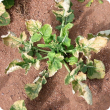Crops
The Department of Primary Industries and Regional Development continues to support the growth and international competitiveness of all crop industries in Western Australia.
With a 2400 kilometre span from its tropical north to its temperate south, WA supports a broad range of cropping industries from rain-fed winter cereals through to irrigated horticultural crops.
In the 2012/13 year the WA cropping industries exported a total of $3.9 billion which comprised: $3.1 billion of cereals, $859 million of pulses, pastures and oilseeds, $142 million of horticultural crops. The major contributors to these exports were wheat ($2.7 billion), canola ($756 million), barley ($377 million), lupins ($42 million), carrots at $48 million, oats ($12 million), and strawberries at $5.5 million.
Articles
Pages
Filter by search
Filter by topic
- Pests, weeds & diseases (14) Apply Pests, weeds & diseases filter
- Control methods (14) Apply Control methods filter
- (-) Remove Grains filter Grains
- (-) Remove Canola filter Canola
- (-) Remove Chemicals filter Chemicals
- Herbicides (7) Apply Herbicides filter
- Crop diseases (6) Apply Crop diseases filter
- Fungi (6) Apply Fungi filter
- Diseases (6) Apply Diseases filter
- Fungicides (5) Apply Fungicides filter
- Grains research & development (3) Apply Grains research & development filter
- Pests (2) Apply Pests filter
- Pest insects (1) Apply Pest insects filter
- Pulses (1) Apply Pulses filter
- Viruses & virus-like (1) Apply Viruses & virus-like filter
- Wheat (1) Apply Wheat filter
- Oats (1) Apply Oats filter
- Nematodes (1) Apply Nematodes filter
- Barley (1) Apply Barley filter
- Insecticides (1) Apply Insecticides filter
- Lupins (1) Apply Lupins filter
- Mechanical, physical and cultural (1) Apply Mechanical, physical and cultural filter
- Bacteria (1) Apply Bacteria filter









